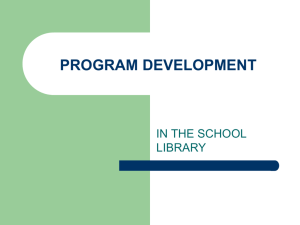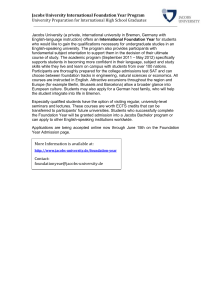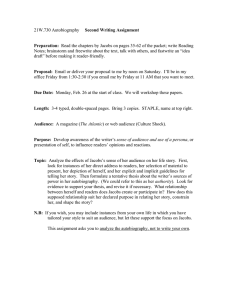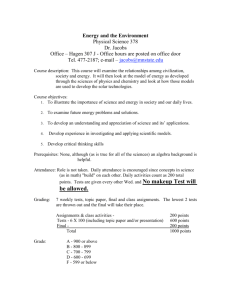Fall 2014 CP 630 Seminar in Urban Planning Implementation Dr. Roger Caves
advertisement
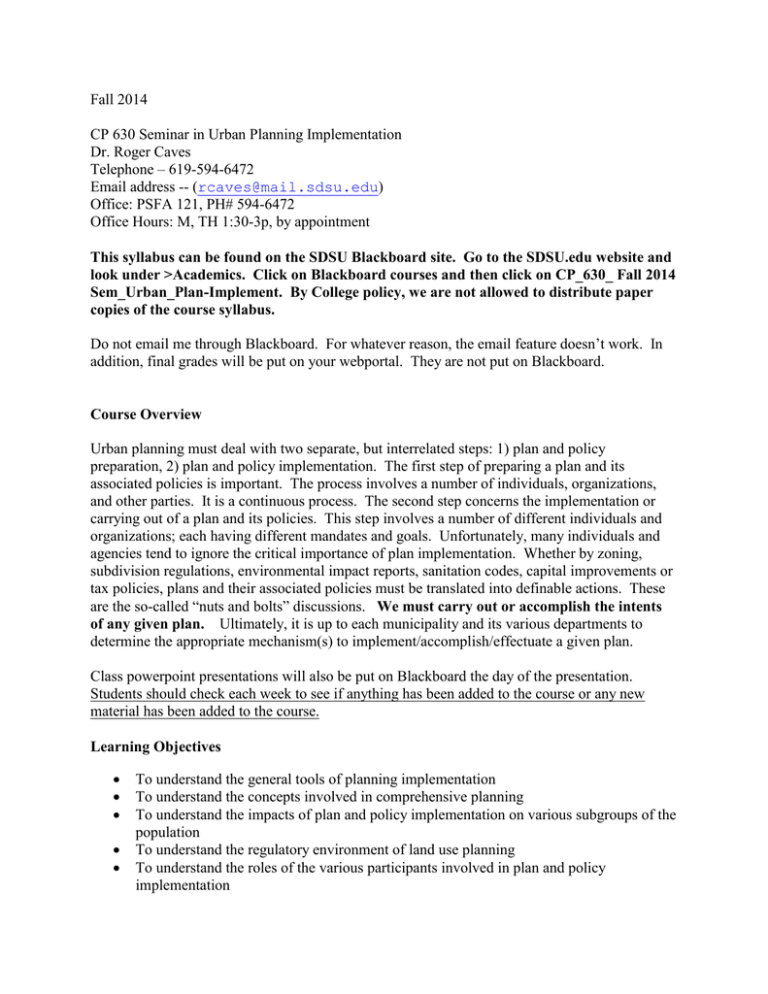
Fall 2014 CP 630 Seminar in Urban Planning Implementation Dr. Roger Caves Telephone – 619-594-6472 Email address -- (rcaves@mail.sdsu.edu) Office: PSFA 121, PH# 594-6472 Office Hours: M, TH 1:30-3p, by appointment This syllabus can be found on the SDSU Blackboard site. Go to the SDSU.edu website and look under >Academics. Click on Blackboard courses and then click on CP_630_ Fall 2014 Sem_Urban_Plan-Implement. By College policy, we are not allowed to distribute paper copies of the course syllabus. Do not email me through Blackboard. For whatever reason, the email feature doesn’t work. In addition, final grades will be put on your webportal. They are not put on Blackboard. Course Overview Urban planning must deal with two separate, but interrelated steps: 1) plan and policy preparation, 2) plan and policy implementation. The first step of preparing a plan and its associated policies is important. The process involves a number of individuals, organizations, and other parties. It is a continuous process. The second step concerns the implementation or carrying out of a plan and its policies. This step involves a number of different individuals and organizations; each having different mandates and goals. Unfortunately, many individuals and agencies tend to ignore the critical importance of plan implementation. Whether by zoning, subdivision regulations, environmental impact reports, sanitation codes, capital improvements or tax policies, plans and their associated policies must be translated into definable actions. These are the so-called “nuts and bolts” discussions. We must carry out or accomplish the intents of any given plan. Ultimately, it is up to each municipality and its various departments to determine the appropriate mechanism(s) to implement/accomplish/effectuate a given plan. Class powerpoint presentations will also be put on Blackboard the day of the presentation. Students should check each week to see if anything has been added to the course or any new material has been added to the course. Learning Objectives To understand the general tools of planning implementation To understand the concepts involved in comprehensive planning To understand the impacts of plan and policy implementation on various subgroups of the population To understand the regulatory environment of land use planning To understand the roles of the various participants involved in plan and policy implementation 2 To understand the complexities involved processing permits To understand the importance of intergovernmental and intragovernmental cooperation and coordination To understand alternative means of mediating and resolving land use or environmental disputes To display knowledge in the above areas by research and writing a research paper on a planning or policy implementation topics Assessment of Learning Objectives Several means will be used to assess the student’s ability to learn and assimilate the materials discussed in class. 1. Each student will be tested, through essay questions, to determine the student’s ability to comprehensive and synthesize materials discussed in class. 2. Active classroom participation will be used to determine the student’s ability to phrase questions and to respond to questions covered on the materials discussed through the semester. 3. Each student will be responsible for researching and writing papers designed to show the student’s ability to write in a clear and coherent fashion. 4. Each student will be asked to lead the class in discussions on various topics throughout the semester. Format and Requirements This course will be conducted in a seminar format -- participation in class is imperative. Simply appearing in class is not enough. The course consists of readings, lectures, discussions, and guest speakers. Students are expected to have read the assigned materials by the scheduled date and to be prepared to discuss the materials. The instructor will provide an overview of the readings and act as moderator for class discussions. The instructor reserves the right to alter the class schedule as circumstances dictate – with advance notice. Regular class participation is required. Specific members of the class will be asked to take the lead in class discussions. Students will, on occasion, be given additional readings to summarize for the class. Tape recording class lectures and discussions are not permitted without expressed permission by me. 3 Course Grading 1. Classroom participation is weighted 15% of the final grade. Participation is based on both quantity and quality. As noted above, students will be asked to take the lead in discussing various readings. Individual readings may be distributed throughout the semester. 2. Two (2) tests will be given during the semester covering any material contained in the text, lectures, or covered in class by guest speakers. The tests will be comprised of short answers, definitions, and essay questions. The tests will be given on October 16, 2014 and November 20, 2014. Alternative dates are only given under rare circumstances (i.e., medical emergency). Each test is weighted at 20% of the final grade. 3. All students are required to complete an applied planning implementation topic report. The report will require both library research and discussions with various professional planners. No group papers will be approved. Students must have consulted with me on their research projects and must submit a one-paged type description and overview of the paper (this includes your topic, why are you doing it, why is the topic important, what will you be covering, and what types of information sources will be used) no later than Oct. 9, 2014. Failure to submit this one page document will result in a grading penalty of five points off your paper grade. This report must analyze one of the topics covered in class and must examine at least one jurisdiction in the region. This report is weighted at 30% of the final grade and is due no later than December 4, 2014 (there will be a 2 point per day penalty for late papers). Students are required to present the findings of their research to the class. Provide two copies of your paper – one electronic copy and one hard copy. The hard copy will be returned to you. The other copy must be submitted on-line to me at rcaves@mail.sdsu.edu. Use your time wisely and don’t wait until the last moment to get the paper ready. SDSU Plagiarism policy will be enforced. 4. Each student is required to write a critical analysis of Jacobs’ The Death and Life of Great American Cities. This assignment is designed to get students to think about her work and critique it to what is happening to today. The book is considered a classic that was written over 30 years ago. The report is weighted at 15% of the final grade and is due no later than November 6, 2014. Students will also be assigned chapter to present to the class on that date. **Failure to meet the assigned deadlines will result in grading penalties.** Grades are based on the following + and - scale: A AB+ B Betc. = = = = = 93.5 or higher 90.0 - 93.4 86.7 - 89.9 83.5 - 86.6 80.5 - 83.4 4 **There are no opportunities to do extra credit work to raise a grade for any particular assignment or to raise your overall grade. Required Textbooks and Readings 1. Cullingworth and Caves, Planning in the USA, 4th edition, 2014 2. Jacobs, The Death and Life of Great American Cities, 1961 3. Elliott, Duerksen, and Dale, The Citizen’s Guide to Planning, 2009 3. Readings on the Internet. These readings are denoted by the word “Internet.” Course Outline Aug. 28 No class, start reading to the materials for next week. Sept. 4 Distribute Syllabus and General Background Information What is Planning? What is Implementation? Who is involved in planning and plan implementation? Planning Education and Profession Sept. 11 Planning Process and Ethics C&C, Ch.1, 4 ,5 Internet – City of San Diego Planning Commission http://www.sandiego.gov/planning-commission/ What is ethical behavior? Internet -- http://www.planning.org/ethics/ethicscode.htm -- “AICP Code of Ethics and Professional Conduct” Sept. 18 General Plans/Comprehensive Plans/Master Plans – Development, Financing, and Implementation C&C, Ch 7, 8 Internet -- A Citizen’s Guide to Planning in California -- What is a General Plan? Why update the General Plan? http://ceres.ca.gov/planning/planning_guide/plan_index.html Sept. 25 Land Use Controls, Growth Pressures, Tools to Limit and Accommodate Growth and their Implementation C&C, Ch 6, 9, 10 Internet – City of La Mesa Zoning Ordinance http://www.bpcnet.com/codes/lamesa/ Click on California and then click on La Mesa Title 24 -- Zoning Internet – City of La Mesa Subdivision Regulations http://www.bpcnet.com/codes/lamesa/ Click on California and then click on La 5 Mesa Title 22 – Subdivision Regulations Internet – Form-Based Code Factsheet http://www.lgc.org/freepub/docs/community_design/fact_sheets/form_based_codes.pdf Internet -- Ahwahnee Principles -- http://www.lgc.org/ahwahnee/principles.html Oct.2 Discretionary permits/map processing in the City of San Diego Guest Speaker: Mike Westlake, Program Manager, City of San Diego, Development Services Department Internet -- http://www.sandiego.gov/development-services/ Oct. 9 General Plans, Adoption Procedures, Citizen Participation, and Financing Guest Speaker: John Conley, Director of Community Development/Engineering Internet -http://www.cityofvista.com/departments/communitydev/documents/FinalVistaGeneralPlanUpdat e.pdf *** Research Paper Topic Outline/Description Due*** Oct. 16 Test #1 Oct. 23 Environmental Planning C&C Ch 16, 17, 18 Internet -- http://www.ecoconceptsrealty.com/what-is-sustainable-planning Internet -- http://www.philaplanning.org/plans/sustain.pdf Oct. 30 Environmental Planning: Planning and Implementation from a Practical Perspective Guest Speaker: John Bridges, FAICP, Principal, AECOM Internet -- CEQA: Summary http://ceres.ca.gov/topic/env_law/ceqa/summary.html Internet -- CEQA: Process Flow Chart http://ceres.ca.gov/topic/env_law/ceqa/flowchart/index.html Nov. 6 Jane Jacobs Discussion and on The Death and Life of Great American Cities You should have read the entire book by this date. Students will be assigned various chapters/parts of this book to present in class *** Jane Jacobs Assignment Due November 6, 2014*** Nov. 13 Regional Transportation Planning Guest Speaker: Dave Schumacher, Principal Planner, SANDAG C&C, Ch 13 Nov. 20 Test #2 ???????Nov. 15 Planning and Development Issues 6 C&C, Ch. 11, 12, 14, 15 Nov. 27 NO CLASS – THANKSIVING HOLIDAY Dec. 4 STUDENT PAPER PRESENTATIONS (10 MIN. EACH) – if you do a Powerpoint presentation, send me the presentation a day before class so I can put it on a flash drive *** Research Papers Due*** Dec. 11 STUDENT PAPER PRESENTATIONS (10 MIN. EACH) – if you do a Powerpoint presentation, send me the presentation a day before class so I can put it on a flash drive Dec. 31 GRADES DUE TO REGISTRAR 7 Seminar in Urban Planning Implementation Fall 2014 RESEARCH PAPER ASSIGNMENT REQUIREMENTS All papers must be related to a topic that we will be discussing in class this semester and must be approved by me. Students will be required to submit a one-page abstract/outline/outline of what they want to do. 1. Length of Paper: Each paper must be a minimum of 20-25 double-spaced typed pages. Maps, footnotes/endnotes/bibliography, etc. are not considered types pages. Students should consult with a style manual and be consistent. Two copies of your paper are to be submitted to me – one hard copy and one submitted on-line to me at rcaves@mail.sdsu.edu. One of the copies will be returned to you. 2. Grades will be based on the following: Ability to focus the paper on a specific planning implementation topic; Clear understanding of the issue(s) involved in the topic’ Ability to write in a clear and understandable fashion Evidence that you have clearly researched the topic in and out of the library. This is generally considered to be a review of past research that has been conducted on the topic. A great deal of information can also be found on the Internet; Ability to use your viewpoint on the topic being discussed; Ability to organize the paper in a clear and organized fashion; Proper use and citations of footnotes and bibliography. 3. You must discuss your paper topic and have it approved by me and must submit a one-page description/outline of your paper by Oct.9, 2014. Failure to do so will result in a penalty of 2pts. off your research paper grade. 4. The final paper is due no later than Dec. 4, 2014. There will be a penalty of 2pts. per day for late papers. Submit two copies of the paper. One copy will be returned to you. 5. Students will present their papers on Dec. 4 and Dec. 11, 2014. Presentations will be no longer than 10 minutes each. More discussion to follow. Failure to present your paper will result in a 5 point penalty. 8 SAMPLES TOPICS FOR RESEARCH PAPERS Alternative means of enforcing zoning codes Alternative means of enforcing housing and noise codes Planning for growth in the coastal zone The Fairness of Impact Fees Alternative mechanisms for regulating adult entertainment Downtown development Streamlining Subdivision regulations Implementing Habitat Conservation Plans Alternative means of controlling population growth Citizen participation in the planning implementation process Downzoning as a growth control technique Regulating the Placement of Satellite Dish Antennas Implementing sustainability plans and programs Implementing Urban Design Guidelines Inclusionary zoning in Southern California PUD’s as a zoning flexibility device Implementing Smart Growth Policies New Urbanism: Implementation Issues Developing and Implementing a Transit-Oriented Development Creating and Implementing Sustainable Development in Localities Implementing Urban Forestry and Community Gardening in California Developing and Implementing Bike and Pedestrian Plans in California Landscape Regulations in an Arid Climate Infill Development Policies in a Growing Region CP 630 Paper Preparation Papers must be configured as follows: Software: Use MS Word for PC (preferred) or Rich Text Format (RTF). Type: Use 12 point Times New Roman type or equivalent at all times. Spacing: Double-space ALL copy (including quoted matter, notes, references, tables, and captions). Left justify the main text and indent first lines of paragraphs. Margins: Use page margins of at least 1 inch left and right and 1 inch top and bottom. Graphics: Group tables or figures together, at the very end of the paper. Place each on a separate sheet and include a caption (number and title). Place captions above tables and 9 below figures and keep them brief — locate explanations in the text. In the text, indicate the appropriate location for a figure or table centered on a separate line, after the first paragraph where it is mentioned. Use the form: [Figure 1 about here] Notes: Put numbered explanatory notes in endnote form. Use sparingly and keep them brief. You can use the style manual of your choice. The idea is for you to be consistent throughout the research paper. However, do not use the style where you put a citation at the end of each paragraph. This is very confusing and it can be interpreted that you are saying everything from the paragraph was taken from this citation. If you want a recommendation, for matters of style — especially text citations and references — I would recommend the following MLA style. Examples of Reference Citations Books Ackerman, L. Identity is destiny. San Francisco: Berrett-Koehler, 2000 Trout, J. & Miller, S. Building brandwidth: Closing the sale online. New York: HarperBusiness, 2000 Article in Edited Book Teitz, M. “Reflections and research on the U.S. experience” The profession of city planning: Changes, images, and Challenges, 1950-2000 L. Rodwin & B. Sanyal, Eds. New Brunswick, NJ: Center for Urban Policy Research, 2000: 275-304. Article in Journal Friedmann, J. The utility of non-Euclidian planning. Journal of the American Planning Association, 60, 1994: 377-379. Internet Site World Tourism Organization. (2002) Facts and figures. Retrieved November 8, 2002, from http://www.world-tourism.org Government Publication Department of Community Affairs. Affordable housing needs assessment -- state, regional and county summaries. Tallahassee, FL: author, 1998. 10 Article in Newspaper Hernandez, R. “Political battle looming over superfund plan,” New York Times (national ed.). April 2002: A22. Paper presented at a Conference Rouse, J. It can happen here: A paper on metropolitan growth. Paper presented at the Conference on the Metropolitan Future, Berkeley, CA, September 26, 1963. Personal Interview Caves, R. Personal Interview. 15 October 2002. For other examples of reference citations, you wil need to consult an MLA Manual. Citing materials within the text Using the above reference citations, you would have something like the following two examples: When simply referring the reader to materials that discuss this general area – Ex. History is one of the keys to understanding a city (Caves, 2002; Friedmann, 1994; Teitz, 2000). If you are quoting directly from material that someone else has said or published, you must give the individual(s) credit. Ex. According to Teitz (2000), “the history of a city can be discussed in three major ways” (p.281). 11 Critical Analysis of Jane Jacobs’ The Death and Life of Great American Cities As you read Jane Jacobs’ The Death and Life of Great American Cities, you undoubtedly know that her ideas and beliefs have evoked a great of discussion on the future of our cities. Many individuals feel her book is simply an attack on planners. Other individuals have broadened the discussion by suggesting it is an attack on decision-making. Jacobs describes how a city can be made safe, how cities function, and why many efforts to improve cities have failed. She discusses the importance of density to a city, the importance of sidewalks, and the importance of diversity. She sees a city has more than just bricks and mortar. To her, they are a living entity. As such, cities are not static; they change for better or worse. Informed choices have to be made. The purpose of this critical analysis is for you to discuss the book and the ideas contained it. You will need to examine the book in its entirety and then to examine its various subthemes/parts. Jacobs’ ideas continue to get students and the general public to think about what we have and what we want cities to look like. Whether or not you agree with Jacobs and ideas is not the issue or point. The issue or point is to have you start questioning things occurring in our cities and to start formulating your own views of planning and development. Your analysis must correspond to the questions below. It should be written just like any other paper. Do not break it down into parts like Question #1, etc. Break the paper down into understandable subheading that flow from one section to the next section. Questions to answer: What are the main points made by Jacobs in the book? What does she see as problems of the cities? Do you agree or disagree with her? As a planning student, how would you respond to her ideas today? Justify your responses. According to Jacobs, what conditions are needed to generate diversity? Discuss them. Why are streets important to Jacobs? What qualities does she look for in a street? What does she think about public housing? Do you agree or disagree? Do you know of any cities or read of any cities that have incorporated some of her ideas? Provide some examples. If this book was written today, how do you think planners would view it? Justify your answer. 12 Grading: The paper will be graded using the following criteria: Clear understanding of the issue(s) discussed by Jacobs; Ability to write in a clear and understandable fashion; Ability to use your viewpoint; your views/opinions are important; Ability to organize the paper in a clear and organized fashion; If you quote anything from Jacobs, make sure you cite the specific page(s). Length of Paper: Your paper should be a maximum 6-7 pp. in length. It must be double-spaced with 12pt. font. If you give me a single-spaced paper, I will return it to you. Date Paper is Due: The paper should be submitted to me on Nov. 6, 2014. Late papers will be penalized 2 pts./day. If you will be absent the date the paper is due, you should submit it to me before the required date, not after.
